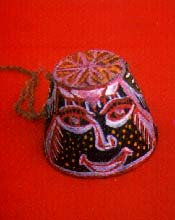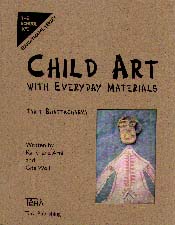|
________________
CM . . . .
Volume VI Number 13 . . . . March 3, 2000
excerpt: My work with children must be viewed in the context of the educational philosophy of our school. We encourage activities which bring in global consciousness and environmental awareness. Our ethos emphasizes originality and independent thinking. Questioning the influence of the media is also part of our agenda. We do not encourage comparison - there are no art competitions. At the same time, there is an emphasis on the simple and natural. Art is integral to our education - it has an important role in academic as well as non-academic fields.  This introductory statement by Tarit Bhattacharya, the art teacher in The School in Madras (one of
seven Krishnamurti Foundation schools in India), sets out the central premises of Child Art with
Everyday Materials: art should be an important feature in the general education of all children;
children's art should evolve from local culture; and the materials used should be sensitive to
environmental concerns. These goals certainly harmonize with art education philosophy in
Canada. For this reason, the book should be appealing to a Canadian audience. It also provides
some fascinating insights into Indian culture. Although Tarit Bhattacharya's exemplary art
program is featured here, the book is a collaborative effort, with much of the writing being done
by authors Kanchana Arni and Gita Wolf.
This introductory statement by Tarit Bhattacharya, the art teacher in The School in Madras (one of
seven Krishnamurti Foundation schools in India), sets out the central premises of Child Art with
Everyday Materials: art should be an important feature in the general education of all children;
children's art should evolve from local culture; and the materials used should be sensitive to
environmental concerns. These goals certainly harmonize with art education philosophy in
Canada. For this reason, the book should be appealing to a Canadian audience. It also provides
some fascinating insights into Indian culture. Although Tarit Bhattacharya's exemplary art
program is featured here, the book is a collaborative effort, with much of the writing being done
by authors Kanchana Arni and Gita Wolf.Child Art... is organized in a way that encourages accessibility and creativity. Throughout the book, projects are described with simple instructions on how to get started and suggestions for variations and extensions. The first two-thirds of the book is devoted to art experiences which develop familiarity with basic art elements: Lines and Designs, Colours, Shapes and Spaces, Textures and Impressions, Forms. The last third of the book is divided into two sections. "Combinations and Compositions" helps students develop harmonious compositions. "Explorations and Transformations" shows students how to make use of accidents and "mistakes," an important step in the creative problem-solving process. Both in its visual appearance and text, the book proclaims its championship of everyday materials. Coil-bound between covers of recycled cardboard, the brown paper pages are illustrated with both simple printed images and coloured reproductions of actual children's artworks which appear to have been cut out and glued in by hand. Projects consistently emphasize the use of inexpensive and recycled materials. Interesting for Canadian readers are the instructions for how to use local Indian media like newspaper sticks, straw, mud, and vegetable dyes. Several projects emphasize the importance of working with authentic imagery from local culture and folk traditions, rather than adopting stereotypes from the media. Although this book has a few drawbacks for North American art educators (it discourages, for example, the study of "great artists" because that may prove boring or intimidating), it nevertheless has many strengths. Child Art... should prove to be a good resource for parents and teachers who want to supplement standard art experiences with a very exploratory approach to media. It will also provide excellent ideas for teachers, working in a social studies context, who want to create "real" contemporary Indian art with their students. Older children, of course, will want to use this book on their own. Recommended. Ann Stinner is an art education instructor in the Faculty of Education at the University of Manitoba.
To comment on this title or this review, send mail to cm@umanitoba.ca.
Copyright © the Manitoba Library Association.
Reproduction for personal use is permitted only if this copyright notice
is maintained. Any other reproduction is prohibited without
permission.
Published by
TABLE OF CONTENTS FOR THIS ISSUE - March 3, 2000.
AUTHORS |
TITLES |
MEDIA REVIEWS |
PROFILES |
BACK ISSUES |
SEARCH |
CMARCHIVE |
HOME
|
